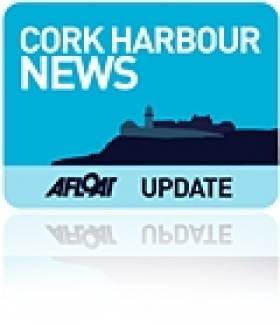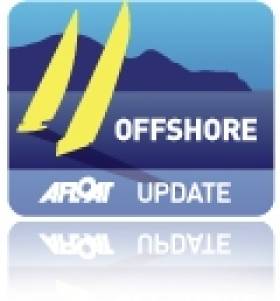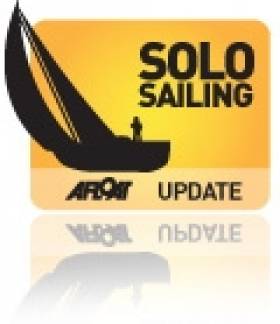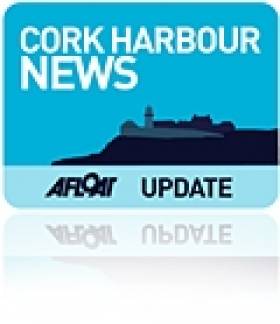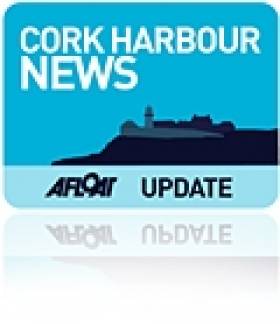Displaying items by tag: Alex Thomson
Emergency for HUGO BOSS in Transat Jacque Vabres: Alex Thomson & Guillermo Altadill Rescued
Alex Thomson and Guillermo Altadill, skippers of yacht HUGO BOSS in the Transat Jacques Vabre set off their emergency beacon this afternoon at 13.25UT. The Spanish Coastguard was informed and sent a rescue helicopter to their location 82 nautical miles from the Spanish coast. Both Alex and Guillermo were rescued from the location by helicopter and are on their way back to land. See rescue video here.
As Afloat.ie reported earlier this week, HUGO BOSS incurred some structural damage earlier this week forcing Alex and Guillermo to stop racing. The Skippers had made a repair and were on route to A Coruna where the technical team were waiting to meet them. After sailing for a period of 36 hours in high seas and strong winds, the structure of the boat deteriorated further and the boat started to take on water and sink. The technical team are in A Coruna, Spain awaiting further information from the coast guard.
In October Thomson and the brand new Hugo Boss made a pit stop in Cork Harbour because of 'small issues with the keel ram' but there is no information if this issue is in any way connected with today's evacuation.
Managing Director Stewart Hosford expresses ‘Our first concern is with Alex and Guillermo and when they are safely on the ground we will address the situation with our IMOCA 60 and begin the salvage process. We are grateful for the swift response from the rescue services in this situation.’
Pit Stop for Solo Sailor Alex Thomson at Cork Harbour Marina
British solo sailor Alex Thomson was back in Irish waters yesterday when he returned to James O'Brien's Cork Harbour Marina for a pit stop on his new IMOCA 60 Hugo Boss yacht.
Looking for all the world like a prop from the latest Batman movie, the new Hugo Boss 'Bat Boat' came out the shed this month after a two year process of design. With a black deck and black hull, this HUGO BOSS is the first ever all black yacht for skipper Thomson.
Pulling into the Irish south coast, Thomson said there were 'small issues with the keel ram'.
The VPLP/Verdier and Alex Thomson Racing Team designed yacht has a honeycomb pattern on the deck, designed by industrial artist Konstantin.
See below for the facebook video of initial keel tests in Gosport, it's worth a look...
HUGO BOSS completes the 180 righting test, this is an important moment before Alex and Guillermo can begin sail testing and training. Alex first needs to prove that the hatch to the stern of the yacht is accessible whilst upside down and that he can right her using the Keel. This is worth a watch, enjoy!#BackToBlack #SailSurviveSucceed #OceanMasters
Posted by Alex Thomson Racing on Wednesday, 23 September 2015
#MastWalk Wins Best Use of PR
#mastwalk – The latest stunt created by Alex Thomson Racing saw the single handed skipper take a dramatic dive from the tip of the HUGO BOSS mast. The #MastWalk has been a viral sensation with his channel boasting over a million views in a matter of days. The stunt required organisation and attention to detail. Alex Thomson Racing had to modify the vessel to achieve this magnificent stunt. Hazards and dangers with completing the footage required Alex Thomson and his team to plan, train and of course find the perfect conditions. The crew worked together to ensure a global media sensation. The helmsman had little steerage as the tip of the rudder skimmed the surface of the sea.
The yacht HUGO BOSS had to remain heeled over at 60 degrees to ensure Alex could walk the 30 metre mast and dive from great height, with this amazing racing machine on the edge of broaching. Philip Burghaus Marketing Manager from HUGO BOSS said "We did not expect to win this award but as a major sponsor of sailing, we believe sailing as a sport provides outstanding sponsorship value as demonstrated tonight" Alex Thomson Racing achieved the #MastWalk viral sensation working alongside the media production company WING and their PR agency PHA media boasting over 1.5 million views in a matter of days.
Working alongside HUGO BOSS Alex Thomson Racing produced a unique and innovative way to create an award winning Digital PR campgain.
#haulbowline – Marine minister Simon Coveney says there has been no final decision taken on an 'Ocean Yacht Racing Hub' within the Naval Service base at Haulbowline island in Cork Harbour.
In this morning's Irish Times newspaper, marine correspondent Lorna Siggins writes that a British yacht racing consultancy has met Government agencies as part of a 'grand plan' for haulbowline island, site of a former steelworks site. The plan for the yacht base was first mooted by British solo racer Alex Thomson when he called into to Cork Harbour for repairs last April before heading across the Atlantic Ocean.
As Afloat.ie reported last October, Thomson, together with his shore manager Stuart Hosford, a Cork native, returned to the harbour and gave a public lecture about his solo sailing success that also included comment about the potential to develop the harbour site. The visit was part of an 'Innovation Week' in Cork where Cork Institute of Technology, the Irish Naval Service and University College Cork promoted the first Imerc Innovation Week.
Interest in the Haulbowline site focuses on the substantial graving dock where large yachts measuring up to over 100–foot in length or more could be lifted in an out of the water in a deep water environment with convenient access to the Atlantic.
Haulbowline has been making headlines for years because of cancer-causing residue, left over from the Irish Steel plant that once occupied the land. It has been confirmed that a cache of 500,000 tonnes of slag and toxic waste material were buried at the former steelworks. Afloat reported on the hot site in the harbour in 2011.
More in the Irish Times on the Yacht Hub story here.
Alex Thomson Explains Dismasting Incident That Took Hugo Boss Out Of Barcelona World Race
#BarcelonaWorldRace - "One of the most painful experiences of my sporting life" is how Alex Thomson describes the dismasting incident on the IMOCA 60 Hugo Boss that took him and Alex Pepe out of the Barcelona World Race.
As previously reported on Afloat.ie, the pair were in the lead of the global two-man-crew offshore challenge when they lost their rig on Wednesday evening (14 January) some 370 nautical miles off the Brazil coast.
Speaking from the South Atlantic yesterday (15 January) en route to Salvador, Brazil, Thomson outlined exactly what happened on board their monohull.
“At about 9pm Pepe and I were doing a sail change in 18 knots of wind. As we dropped one of our headsails, the furler broke and flew into the air.
"For a few seconds the mast hovered, before falling backwards and into the water. Pepe reacted quickly and we cut the rest away, losing the mast, boom and rigging.
"Of course we are devastated and disappointed. As offshore ocean racing sailors this is a peril of our sport, but it is still painful."
Though the pair are now out of the race, their focus is entirely on attempting to "assess and analyse the problem and learn from this, but we will remain ever determined and resilient to come back stronger and succeed.”
See more on this story at the Alex Thomson Racing website HERE.
#barcelonaworldrace – Tuesday allowed the sixteen skippers who will start the 22,500 miles two handed Barcelona World Race to fully enjoy their final hours on dry land before taking this afternoon's 1300hrs (CET midday UTC) start. At least one of the competing skippers has a connection to Ireland thanks to a pit–stop taken on the south coast last April.
The fleet includes British sailor Alex Thomson who visited Cork twice in 2014. He sailed here first in April in his Open 60 Hugo Boss and stopped off at Cork Harbour Marina for some running repairs prior to a Transatlantic passage. Such was his positive experience in the harbour he returned in October to talk about his sailing plans at a public lecture at Cork's Millennium Hall as part of Cork Innovation Week. At that lecture he said he believed Cork harbour had the 'potential to be a global yacht racing hub'.
Thomson and his co-Skipper Pepe Ribes will sail HUGO BOSS an IMOCA 60 racing yacht 26,000 Nautical Miles, non-stop, unassisted around the globe.
The Barcelona World Race is the only double-handed (two crew per boat), non-stop, round the world regatta. The race takes the sailors on a course that started and will finish in Barcelona. The course will take HUGO BOSS via the Cape of Good Hope, Cape Leeuwin and Cape Horn. The race is a highlight in the IMOCA circuit and part of the prestigious Ocean Masters World Championships.
The last time Thomson competed in The Barcelona World Race was back in 2007-2008, when he and his co-skipper at the time, Andrew Cape, finished the race in second place.
This time around, Thomson is competing alongside co-skipper, Pepe Ribes; one of Spain's most experienced and well respected sailors. Thomson and Ribes have over 35 years offshore racing experience between them, and are competing onboard a new generation IMOCA 60.
Thomson made headlines in 2013 when he successfully completed the gruelling Vendee Globe - a solo, unassisted round-the-world race - breaking a British record along the way. Comparing the challenges of the Vendee Globe and the BWR, Thomson said;
"The Barcelona World Race is mentally easier than the Vendee Globe because you have another person there with you. But the Barcelona World Race is a more difficult race physically than the Vendee. It's a double handed race, so while there are two of you onboard, you are racing the boat to its full potential so it requires more physically."
Speaking about his co-skipper, Thomson said; "I met Pepe about four years ago when he was another skipper in the race. He has been working with us for about a year and we have got to know each other well. We've done thousands of miles together. We are quite different characters, we look at things in very different ways. But that's a positive thing. Because we are less likely to let a detail slip."
The Barcelona World Race will take up to 90 days to complete
The start will be given by Barcelona's Mayor Xavier Trias with the line set in front of the iconic 90m tall Hotel Vela (W-Hotel). The mayor will signal the start with a traditional sound as well as the emblematic lowering of the 'flags' on a new sculpture on the Placa del Mar on the Barcelona sea-front.
The onshore activity will begin at 10 am when the IMOCA 60s bid their farewells and dock-out from the pontoons at the base of the Columbus statue. From 12.30 pm on the beachfront a starting ceremony will begin with a live performance by the Fura del Baus musicians at the Dona del Milleni sculpture. Xavier Trias, will drive the mechanism that moves the arms, waving a flag signal, which will start the circumnavigation of the globe.
After the gun there are two options for a circuit along the beach before heading south towards the exit from the Med. The most likely is a two miles reach to a turning mark where the fleet will pass before heading for the Strait of Gibraltar, 535 miles down the track. Winds are forecast to be light around start time.
The meteo situation suggests there will be a variety of options after that final turning mark, and hence the fleet could possibly spread. Initially there might be the choice to go east to hook into the existing stronger breeze or wait until it is filled across to the Spanish coast. Essentially Barcelona lies in no-go zone, between the winds. The brisk NE'ly will carry the leaders down to the Balearics by between 2200hrs and midnight (about 90 miles) where the routing suggests passing just to the east of Ibiza. The winds through this first night will peak at just over 20kts but after the Balearics through the early hours the winds will ease, receding from the shore.
Barcelona World Race 2014-15 entries:
Cheminees Poujoulat, Bernard Stamm (SUI) and Jean Le Cam (FRA)
GAES Centros Auditivos, Anna Corbella (ESP) and Gerard Marin (ESP)
Hugo Boss, Alex Thomson (GBR) and Pepe Ribes (ESP)
Neutrogena, Guillermo Altadill (ESP) and Jose Munoz (CHI)
One Planet One Ocean Pharmaton, Aleix Gelabert (ESP) and Didac Costa (ESP)
Renault Captur, Jorge Riechers (GER) and Seb Audigane (FRA)
Spirit of Hungary, Nandor Fa (HUN) and Conrad Colman (NZL)
We Are Water, Bruno Garcia (ESP) and Willy Garcia (ESP)
Cork Has 'Potential to be Global Yacht Racing Hub', IMERC Hears
#corkharbour – International yachting star Alex Thomson told an IMERC conference in Cork last night of the yachting opportunities for Cork Harbour. "I am delighted to be visiting Cork and working with the harbour here. I see Cork as a fantastic location for a global yacht racing hub with a perfect harbour allowing protection and natural depth as well as direct access to the Atlantic, the British sailor told the conference. 'We hope that we can support the growing ambition to develop something fantastic here in Cork harbour." The manager of Alex's team, Stewart Hosford added that "We are in discussion with Imerc to see how we can support Minister Coveney's ambitions for Cork Harbour. As a young boy who grew up sailing in Cork Harbour I am very excited about the opportunities for Cork and Ireland."
Last night's conference also heard that Ireland has a huge wave energy resource off its western coast with marine renewable energy potentially providing four times the amount of energy Ireland requires. Many companies are innovating in this space trying to find the technology that will harness the wave energy to make this a reality. Imerc is delighted to announce that one of those companies, Irish wave energy company Jospa, have won the Imerc Innovator of the Year Award.
Jospa have developed an Adjustable Break Fin technology that may double the output from wave energy devices at marginal extra cost. Jospa's technology could be the breakthrough wave energy needs if it is to meet its promise. A panel of high profile judges representing government and industry selected Jospa as the winner of the award.
Ian Venner, Partner at EY, who was a judge for the competition, said "Like all great innovations, the Jospa innovation is very simple but has the potential to have a profound impact on the wave energy sector. I will certainly keep an eye on how they progress over the coming months and years."
Joss Fitzsimons of Jospa, who design and make their own models and test equipment, said "The Imerc award is important for us as an acknowledgement of attainment through our careful progress. Good planning and engineering make it possible to approach success in wave energy without spending astronomic amounts. Based on a still-modest valuation, Jospa seeks investors of quite small amounts."
Round–the–World Yachtsman Alex Thomson to Give October Talk in Cork
#alexthomson – Sailing superstar Alex Thomson returns to Cork next month to speak about his life on Thursday, October 16th at 8pm in a free public lecture at Cork's Millennium Hall, City Hall. Thomson sailed into Cork Harbour in April when he and his crew were not far off Land's End in Cornwall after a leak discovered in the starboard ballast tank required overnight repairs. The British skipper in his Open 60 Hugo Boss made a surprise visit to Cork Harbour Marina in Monkstown Bay to make runnig repairs and took the time to give some 50 local junior sailors a tour of the vessel.
One of the most exciting and talented yachtsmen of his generation, Alex is the youngest sailor ever to win a round the world race, he has already broken three world records in sailing and he most recently cemented his reputation with a podium third place finish in the 2012/2013 Vendée Globe.
The visit is part of an innovation week in Cork. Imerc partners of Cork Institute of Technology, the Irish Naval Service and University College Cork have announced details of the first Imerc Innovation Week will take place in Cork from October 15th to 18th. Imerc, Ireland's Maritime Cluster, will host a range of free lectures, competitions and networking events. Imerc is one of the most exciting maritime and energy initiatives in the world establishing a campus of global significance in Cork Harbour that will house a unique mix of industry, research and training facilities.




























